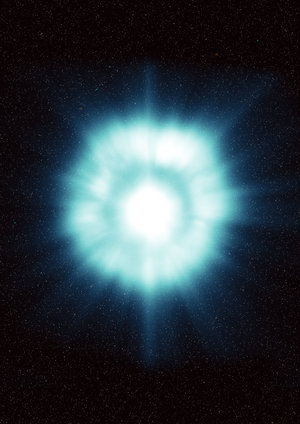Integral looks at Earth to seek source of cosmic radiation
Cosmic space is filled with continuous, diffuse high-energy radiation. To find out how this energy is produced, the scientists behind ESA’s Integral gamma-ray observatory have tried an unusual method: observing Earth from space.
During a four-phase observation campaign started on 24 January this year, continued until 9 February, Integral has been looking at Earth. Needing complex control operations from the ground, the satellite has been kept in a fixed orientation in space, while waiting for Earth to drift through its field of view.
Unusually, the main objective of these observations is not Earth itself, but what can be seen in the background when Earth moves in front of the satellite. This is the origin of the diffuse high-energy radiation known as the ‘cosmic X-ray background’.

Until now with Integral, this was never studied simultaneously with such a broad band of energy coverage since the 1970s, and certainly not with such advanced instruments.
Astronomers believe that the ‘cosmic X-ray background’ is produced by numerous supermassive and accreting black holes, distributed throughout deep space. These powerful monsters attract matter, which is then hugely accelerated and so emit high energy in the form of gamma- and X-rays.
X-ray observatories such as ESA’s XMM-Newton and NASA’s Chandra have been able to identify and directly count a large number of individual sources – likely black holes – that already account for more than 80 percent of the measured cosmic diffuse X-ray background.
However, very little is known about the origin of the highest energy band of this cosmic radiation, above the range of these two satellites. This is spread out in the form of high-energy X- and gamma-rays, within the reach of Integral.

It is believed that most of the gamma-ray background emission is produced by individual supermassive black holes too, but scientists need to couple this emission with clearly identified sources to make a definitive statement. In fact, other sources such as far-away galaxies or close weak sources could be also be responsible.
Identifying the individual sources in the gamma-ray range that make up the diffuse cosmic background is much more difficult than counting the individual X-ray sources. In fact, the powerful gamma-rays cannot be focused with lenses or mirrors, because they simply pass straight through.
So to produce a gamma-ray image of a source, Integral uses a ‘mask’ technique - an indirect imaging method that consists of detecting the shadow of a mask placed on top of the telescope, as projected by a gamma-ray source.

During the observations, the scientists used Earth’s disk as an ‘extra mask’. Earth naturally blocks, or shades, the highest energy flux from millions of distant black holes.
Their combined flux can be accurately measured in an indirect way, that is by measuring the amplitude and the energy spectrum of the energy drop when Earth passes through Integral’s field of view. Once this is known, scientists can eventually try to connect the radiation to individual sources.
All the observations were very successful, as all the gamma-ray and X-ray instruments on board Integral (IBIS, SPI and JEM-X) recorded clear and unambiguous signals in line with expectations.
The Integral scientists are already proceeding with the analysis of the data. The aim is to ultimately understand the origin of the highest energy background radiation and, possibly, provide new clues on the history of growth of super-massive black holes since the early epochs of the Universe.
Notes to editors:
The Earth observation campaign is a successful joint effort of the full Integral Science Working Team (composed of the instrument and data centre Principal Investigators, mission scientists, project scientist and representatives of the Russian and US scientific communities under the leadership of the Russian science working team members who proposed these unique ‘non-routine’ observations).
The campaign required a particularly complex planning and execution, which greatly involved ESA’s European Space Operations Centre (ESOC) and the Integral Science Operations Centre (ISOC).
The Earth campaign is also providing an excellent opportunity to calibrate the Integral instruments. Through a precise characterisation of the cosmic X-ray background, scientists can identify and separate it from the instruments’ normal background signal, for easier data analysis in the future.
As secondary objectives, the Earth observations will also allow astronomers to study the high-energy emission from Earth’s atmosphere. This is coming from the reflection of the X-ray background, from the interaction with cosmic rays and even from aurorae, as preliminary data from these Integral observations have already hinted.
For more information:
Chris Winkler, ESA Integral Project Scientist
E-mail: christoph.winkler @ rssd.esa.int
Arvind Parmar, ESA Integral Mission Manager
E-mail: arvind.parmar @ esa.int
Eugene Churazov, Max Planck Institute for Astrophysics, Garching, Germany
E-mail: churazov @ mpa-garching.mpg.de















 Germany
Germany
 Austria
Austria
 Belgium
Belgium
 Denmark
Denmark
 Spain
Spain
 Estonia
Estonia
 Finland
Finland
 France
France
 Greece
Greece
 Hungary
Hungary
 Ireland
Ireland
 Italy
Italy
 Luxembourg
Luxembourg
 Norway
Norway
 The Netherlands
The Netherlands
 Poland
Poland
 Portugal
Portugal
 Czechia
Czechia
 Romania
Romania
 United Kingdom
United Kingdom
 Slovenia
Slovenia
 Sweden
Sweden
 Switzerland
Switzerland





































